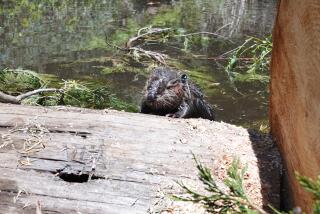New Mexico’s Bighorn Sheep Are Mounting a Comeback
- Share via
MORA, N.M. — The loud cracking of Rocky Mountain bighorn rams butting heads and the shadows of ewes dancing along rugged cliffs disappeared from the Latir Peak Wilderness about a century ago.
But after a weeklong effort by dozens of state and federal wildlife managers, the native bighorn have returned to the small patch of wilderness in northern New Mexico.
“The key about the Latir is it’s the last piece of alpine tundra in New Mexico that does not have bighorn sheep,” said Bill Dunn, a predator specialist with the state Department of Game and Fish and former coordinator of the state’s bighorn sheep program.
“This project is a key stepping stone to genetic intermingling. This is a very important part of our program for long-term conservation,” Dunn said during the relocation of 56 sheep from the Pecos Wilderness near Mora to the Latir.
The Latir has all the elements that make the perfect home for bighorn sheep: water, grassy meadows, open landscape where they can spot predators, and cliffs where they can use their agility to escape any threats.
Dozens of Game and Fish officers, federal range land managers and veterinarians spent a week in August trapping the bighorns--eight rams, 37 ewes and 11 lambs.
After taking a helicopter ride out of the Pecos to a processing site near Mora, the sheep were weighed, their temperatures and blood samples were taken, and they were fitted with radio collars and numbered tags.
The animals were then trucked from Mora to Bobcat Pass near Red River, then airlifted, by helicopter again, to the Latir.
There are about 650 Rocky Mountain bighorn sheep in New Mexico, including herds in the Pecos, Wheeler Peak Wilderness near Taos, the Manzano Mountains southeast of Albuquerque, and two areas in the Gila National Forest in southern New Mexico.
However, bighorns have not fared so well in the Latir. In 1978, big-game managers attempted to repopulate the wilderness, but the herd was wiped out within three years of encountering domestic sheep. It wasn’t until recently that grazing permits for domestic sheep in the Latir expired and state officials were able to coordinate the transplant.
Game and Fish officials said that putting bighorn back in the Latir will bridge the gap between existing populations in New Mexico and southern Colorado.
“When you have just one new animal come in with totally different genetic stock, it makes a world of difference for their genetic makeup,” explained Elise Goldstein, coordinator of the state Game and Fish Department’s bighorn sheep program. “There’s more genetic variety, and that generally leads to healthier animals.”
Six bighorns died during the relocation--among them five ewes being airlifted. Sling-like sacks holding the sheep began to swing out of control below the helicopter, nearly causing the aircraft to crash and forcing the pilot to release them.
Game and Fish officials had expected a mortality rate of up to 8% during the bighorn relocation. Because of the five that died and one earlier in the week, the rate for this reintroduction was about 10%.
Eric Rominger, a contract biologist for the state Game and Fish Department, said the bighorn that were released will be monitored closely using monthly fixed-wing flights, annual helicopter surveys and a backpack survey.
“We’ll judge success after they produce lambs, which will be next June,” he said.
Rominger said the goal is for the Latir herd to reach 100, something that could happen within six years.
“Ecologically, I think the bighorn is an extremely important animal because it basically fills that niche that would otherwise be empty without them,” he said. “We just need to have them back.”
More to Read
Sign up for Essential California
The most important California stories and recommendations in your inbox every morning.
You may occasionally receive promotional content from the Los Angeles Times.













